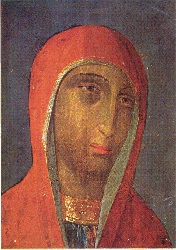- Home
- /
- Our Spirituality
- /
- Our Lady of Philermos
The Knights of Saint John built a basilica on the spot and reinstated the icon, which was venerated as “Our Lady of All Mercies” and became known as “Our Lady of Philermos.” Since then, the Order has been devoted to Our Lady under that title as its protector and patroness. The island was invaded several times unsuccessfully. After the first great siege by the Ottoman Turks in 1480, Mount Philermos was considered insecure and in 1513 the icon was moved to Saint Mark’s in the city of Rhodes. During the second Ottoman siege, in 1522 under Suleiman, the church of Saint Mark was completely destroyed, but the icon was found intact. Running out of supplies, the Knights accepted Suleiman’s offer to depart with military honors. On 1 January 1523, they left Rhodes, taking the icon of Our Lady of Philermos with them.
In 1530, the Order moved to Malta. The icon was placed in the church of Saint Lawrence, which soon was badly damaged by fire, but the icon once again was not damaged. On 19 May 1565, Suleiman began the third and most famous of the Ottoman sieges of the Knights of Saint John, this time in Malta. Although greatly outnumbered, the Order withstood the attacks. On 8 September, celebrated by the Order as the Feast of Our Lady of Philermos, a relief army landed in Malta and the Turks fled.
After Bonaparte captured Malta in 1798, the Order was allowed to remove several important relics and the icon of Our Lady of Philermos. These objects ended their travels in Saint Petersburg under the protection of the Tsar and came to be regarded as the personal property of the Russian imperial family. By the grace of God, the relics were saved from the 1917 revolution, and in 1919 they were taken to Copenhagen. In 1931, they were moved to Yugoslavia and placed under the protection of the king. When the Germans invaded in 1941, the icon was hidden in a monastery in Montenegro. It later was found by Tito and finally placed in a museum in Cetinje, the old capital of Montenegro, but was never displayed. Considered lost for some time, a few years ago the icon was ‘rediscovered,’ and now is on display.

The Sovereign Military Hospitaller Order of Saint John of Jerusalem, of Rhodes and of Malta
The day of our Patroness is 8 September, the Feast of the Birth of the Blessed Virgin Mary, celebrated as a solemnity by the Order under the title Our Lady of Philermos.

Order of Malta
Cuban Association
d/b/a Foundation Order of Malta, Inc.
2655 S. Lejeune Road
Suite 918
Coral Gables, FL 33134
Phone: (786) 888-6494
info@foundationorderofmalta.org
